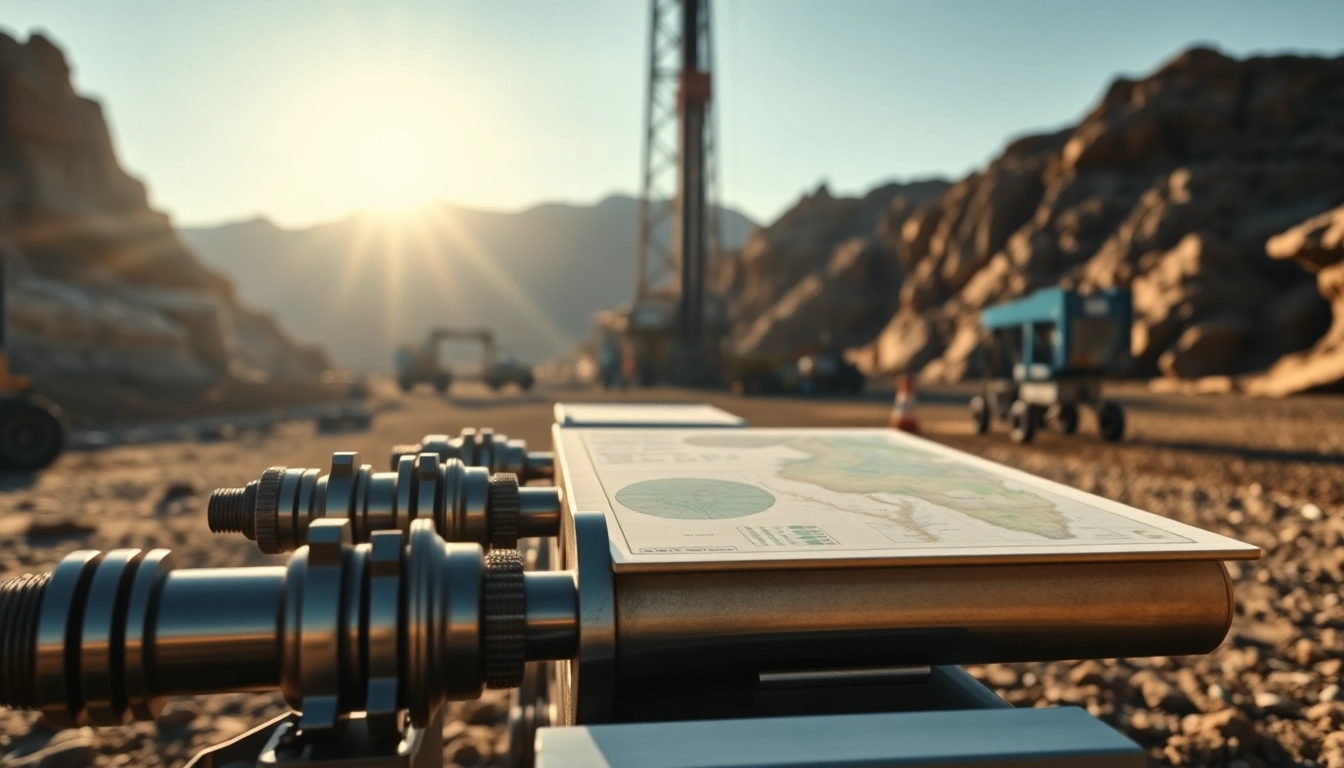Understanding Geosteering
What is Geosteering?
Geosteering is a sophisticated method utilized in the oil and gas drilling industry aimed at optimizing the position of the wellbore relative to geological formations. It incorporates real-time data analysis and sophisticated techniques to navigate subterranean landscapes effectively. By adjusting the drilling process while it is ongoing, geosteering allows for better resource extraction and minimizes potential risks associated with drilling errors.
This real-time methodology stands in contrast to traditional drilling techniques where operators would make decisions based solely on pre-existing geological data. By integrating real-time data from various sensors and technologies, geosteering ensures that drilling teams can respond dynamically to changes in geological conditions. For those in the field, geosteering drastically improves decision-making processes and project outcomes.
Importance of Geosteering in Drilling
The significance of geosteering cannot be understated. It plays a crucial role in enhancing drilling efficiency and maximizing resource recovery. Here are a few reasons highlighting its importance:
- Cost Efficiency: By accurately steering the borehole, geosteering minimizes the risks of drilling into unproductive zones, thus saving time and resources.
- Improved Accuracy: With real-time data and geological modeling, operators can achieve precise well placement, ensuring that they tap into the most productive parts of a reservoir.
- Reduced Environmental Impact: By optimizing drilling paths, geosteering helps minimize the land area disturbed by drilling operations, leading to a reduced environmental footprint.
- Enhanced Recovery Rates: Targeted drilling increases the likelihood of accessing more hydrocarbons, resulting in improved overall recovery rates.
Basic Principles of Geosteering
The foundational principles of geosteering revolve around several key concepts:
- Real-Time Data Acquisition: Employing advanced sensors and data collection methods to gather geophysical and geological data during drilling.
- Geological Modeling: Creating accurate geological models that represent the subterranean environment, which can be continuously updated as new data comes in.
- Dynamic Decision-Making: Enabling drilling teams to make informed decisions on-the-fly based on real-time information, allowing for adjustments to be made immediately instead of relying on static geological reports.
Techniques and Technologies in Geosteering
Real-time Data Utilization
Real-time data utilization is the cornerstone of effective geosteering. This process involves the continuous collection and analysis of geological data from the drilling site, including:
- Mud Logging: Monitoring the composition and characteristics of the drilling fluid to identify changes in rock formations.
- Measurement While Drilling (MWD): Collecting real-time data about the wellbore position and geological formations using advanced sensors.
- Logging While Drilling (LWD): Gathering measurements related to the geophysical properties of the surrounding formations without interrupting the drilling process.
The integration of these technologies allows for efficient tracking of the borehole trajectory and facilitates immediate corrective actions if the drilling deviates from the desired path.
Software and Tools for Effective Geosteering
A variety of software tools and applications are employed to support the geosteering process:
- Geological Simulation Software: Used to model geological formations and predict well performance.
- Data Visualization Tools: Enabled to present real-time data in a user-friendly format, helping teams make quicker decisions.
- Decision Support Systems: Aided with algorithms and data analytics capabilities to recommend optimal drilling parameters.
The combination of these tools equips teams with the information necessary to navigate complex geological terrains confidently.
Advanced Geological Modeling Techniques
Advanced geological modeling techniques play a pivotal role in enhancing the accuracy of geosteering. Some critical methodologies include:
- 3D Geological Modeling: Visualizes subsurface geology in three dimensions, allowing for enhanced understanding and decision-making about the wellbore path.
- Machine Learning Algorithms: Analyzing historical drilling data to predict future drilling conditions and improve the accuracy of geological models.
- Volumetric Analysis: Permit operators to visualize and evaluate the spatial relationships of subsurface resources effectively.
These advanced techniques not only boost the efficiency of geosteering operations but also facilitate better risk management through enhanced predictive capabilities.
Best Practices for Successful Geosteering
Strategies to Optimize Well Placement
To optimize well placement during geosteering, it’s crucial to deploy several best practices:
- Prioritize Accurate Data Collection: Ensuring the consistency and precision of the data gathered during drilling is foundational to effective geosteering.
- Adopt Collaborative Approaches: Facilitating communication among geologists, engineers, and other stakeholders can assist in making shared decisions based on the latest data.
- Continuous Training: Keeping drilling teams trained on the latest technologies and geosteering techniques ensures that they can respond to geological challenges swiftly.
By following these strategies, drilling operations can significantly enhance their chances of successful well placement.
Common Challenges and Solutions in Geosteering
Geosteering, while highly beneficial, does present its own set of challenges, including:
- Data Integration Issues: Challenges might arise when integrating diverse data sources. Using standardized protocols for data collection can help overcome this barrier.
- Geological Uncertainty: Uncertainties in the geological model can lead to misjudgments. Employing multiple modeling techniques can help validate assumptions and reduce risk.
- Technological Limitations: Sometimes, tools may be outdated or insufficient. Regular updates to software and equipment are essential for effectiveness.
Addressing these challenges proactively through technological advancements and refined methodologies can mitigate potential issues and enhance drilling success rates.
Monitoring and Adjusting in Real-time
To maintain an effective geosteering operation, real-time monitoring and adjustments are imperative. This involves:
- Regularly Checking MWD and LWD Data: Continuous assessment of drilling parameters ensures that the operation remains on track.
- Using Feedback Loops: Creating feedback mechanisms allows for rapid adjustments based on incoming data to address any deviations from the planned trajectory.
- Engaging in Post-Drilling Analysis: Conducting reviews post-drilling can provide insights for future projects and highlight areas for improvement.
Through diligent monitoring and adjustments, drilling teams can enhance their operational efficiency and success rates in geosteering.
Case Studies and Applications of Geosteering
Successful Geosteering Projects in Oil and Gas
Numerous case studies have demonstrated the effectiveness of geosteering in optimizing drilling operations:
In one notable project, a drilling team utilized real-time data acquisition to navigate a complex geological formation in a shale gas play. By employing advanced geological modeling techniques, they adjusted their drilling path multiple times within a single day. This proactive approach not only increased the well’s production rate significantly but also reduced total drilling costs by nearly 20%.
Another successful application involved a geothermal drilling project where predictive modeling and advanced analytics were key. By understanding the zones of higher geothermal potential, the team successfully reached the target formation with minimal drilling downtime and maximized energy output.
Lessons Learned from Geosteering Experiences
From various geosteering projects, several valuable lessons have emerged:
- The Value of Real-time Monitoring: Continuous data monitoring can drastically improve drilling accuracy and reduce risks.
- Importance of Collaborative Decision-Making: Engaging a multidisciplinary team helps draw on diverse insights, leading to optimized operations.
- Need for Continuous Adaptation: The ability to adapt to changing conditions is essential in making informed drilling decisions and achieving successful outcomes.
Future Trends in Geosteering
The future of geosteering is poised for exciting advancements, such as:
- Increased Use of Artificial Intelligence: AI and machine learning are expected to enhance predictive modeling, enabling drilling teams to anticipate geological changes more accurately.
- Integration of Remote Operations: As technology progresses, remote operation of drilling rigs will become more common, allowing for safer and more efficient geosteering practices.
- Enhanced Data Analytics: The refining of big data analytics for drilling operations will lead to more precise decision-making and better project management.
Performance Metrics for Geosteering
Key Performance Indicators in Geosteering
To assess the success of geosteering initiatives, drilling teams rely on specific key performance indicators (KPIs) such as:
- Time to Drill: Measuring the total time taken to complete drilling operations can highlight efficiency levels.
- Rate of Penetration (ROP): This reflects how quickly the drill is advancing and is a critical metric for operational efficiency.
- Non-Productive Time (NPT): Keeping track of NPT is essential for identifying inefficiencies or operational delays.
Assessing the Efficiency of Geosteering Techniques
Evaluating the efficiency of geosteering techniques involves an analysis of both performance metrics and qualitative feedback from drilling teams. Key considerations include:
- Comparative Analysis: Evaluating current drilling operations against historical data can identify trends and areas for improvement.
- Team Feedback: Gathering insights from the drilling team can provide valuable context and inform future geosteering strategies.
- Financial Analysis: Assessing cost savings and revenue generated from improved geosteering practices can help justify investments in technology and training.
Reporting and Data Analysis in Geosteering
Effective reporting and data analysis play vital roles in geosteering success. Thorough reports should encompass:
- Real-Time Data Dashboards: Developing dashboards that provide live updates on drilling operations can assist in quick decision-making.
- Post-Drilling Reports: Analyzing performance post-operation can provide critical insights for future projects.
- Key Insights Presentation: Sharing findings with stakeholders ensures everyone is informed on results and future directions.
To further delve into the world of geosteering, professionals can visit www.geosteeringvision.com for additional resources and insights.


